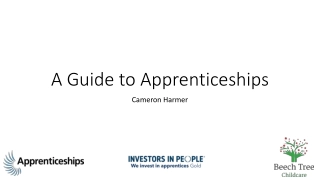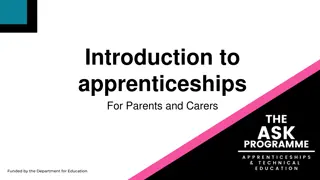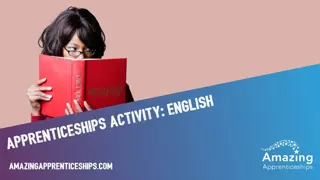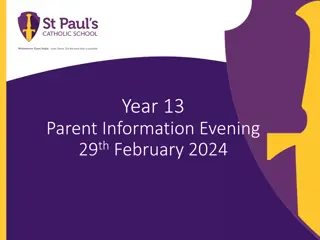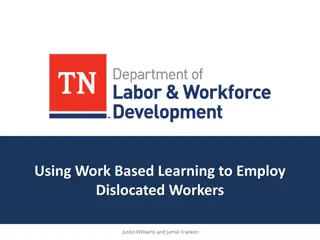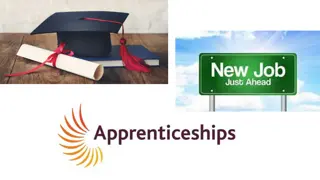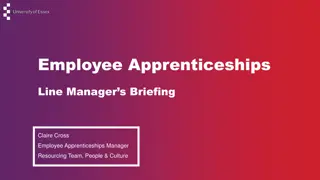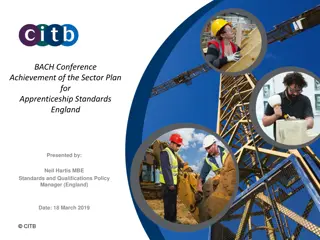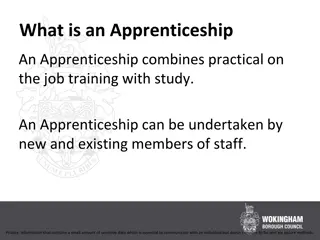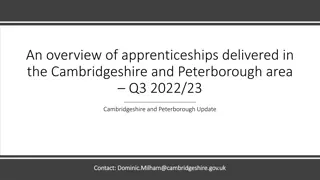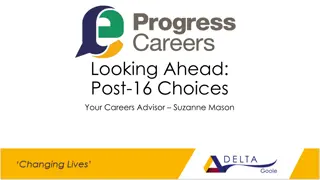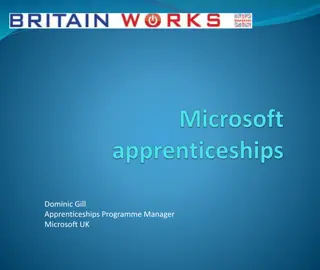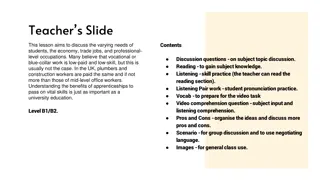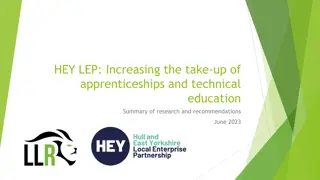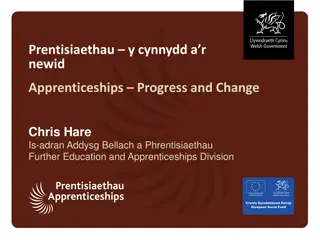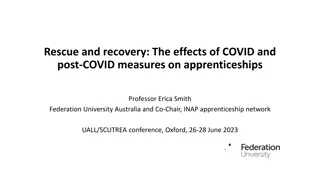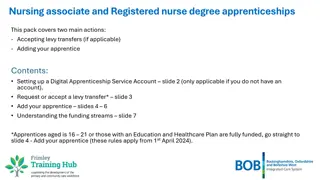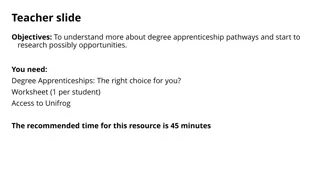Comprehensive Guide to Apprenticeships in Teaching for 2023-2024
Apprenticeships in teaching offer work-based training for individuals aiming to become educators. Employers provide valuable on-the-job training while apprentices work towards nationally recognized standards. This guide covers aspects such as apprenticeship definition, employer engagement, off-the-job training requirements, and more to facilitate a successful apprenticeship journey.
Download Presentation

Please find below an Image/Link to download the presentation.
The content on the website is provided AS IS for your information and personal use only. It may not be sold, licensed, or shared on other websites without obtaining consent from the author.If you encounter any issues during the download, it is possible that the publisher has removed the file from their server.
You are allowed to download the files provided on this website for personal or commercial use, subject to the condition that they are used lawfully. All files are the property of their respective owners.
The content on the website is provided AS IS for your information and personal use only. It may not be sold, licensed, or shared on other websites without obtaining consent from the author.
E N D
Presentation Transcript
Introduction to Teaching Introduction to Teaching Assistant and Assistant and Postgraduate Teaching Postgraduate Teaching Apprenticeships Apprenticeships 2023-2024
What is an apprenticeship? Apprenticeships are work-based training programmes that are designed to help employers train people for specific job roles Apprentices get a paying job with valuable training while they work towards a nationally recognised apprenticeship standard An apprenticeship can be for new or existing staff but must cover new learning
Introduction Apprentices are members of staff Apprentices must have a contract of employment that covers the duration of their programme Apprentices cannot contribute to the cost of their training Apprentices must be allowed time to study Apprentices must be on programme for a minimum of 12 months Employers (Mentors) must attend and contribute to the Apprentice Induction and agree the individual learning plan This is a collaboration whereby BPN supports the Employer and the apprentice
Employer engagement All employers will receive an induction as part of the first day of learning. They will also receive physical and electronic copies of the Employer Handbook and Programme Handbook. Employer Engagement is essential for all Apprenticeships, employers need to be fully aware of their commitment to their apprentice and what they have agreed to, by signing the contracts: Have a dedicated, allocated mentor for each apprentice who will; Be actively supportive & involved, for example monitoring the apprentices Bud portfolio Participate in all face to face and preferably most remote Reviews Release the Apprentice for observations and reviews Plan time out of class for attending training events Provide opportunities for L&D Understand & support OTJT A candidate on a relevant higher-level apprenticeship can supervise a candidate on this programme.
Off the job training (OTJT) is time during the apprenticeship that is allocated to enable apprentices to achieve their apprenticeship outside of their normal day to day working duties made up of 6 hours per week for those working at least 30 hours a week or 20% of the apprentice s programme time if under 30 hours based on the number of hours the apprentice is contracted for TA s may be part time so their programmes will last longer mandatory and must be evidenced paid time within the apprentice s working hours. It must be new learning. is to further develop their knowledge, skills and behaviours linked to their apprenticeship All OTJT is planned for our programmes, for Teachers it is covered by a weekly training day
Examples of Off the Job Training Learning the theory/professional knowledge through: Classes and workshops Lectures Online learning and webinars Relevant reading Research Lunch and learn sessions Role playing and simulation exercises Self-study time CPD sessions if relevant Practical training through: Learning support time spent on: Job shadowing Mentoring Departmental meetings Observing peers and managers Attending meetings Project work Professional networks Events and competitions Visits to wider parts of the department, other departments Visits to other settings Writing self-assessments Writing assignments Reflective journals Revision Peer discussions Preparation for Assessments & Exams One-to-one tutorials (with apprenticeship coach, line manager or colleagues) that contain guided learning or support for the apprenticeship Remember reading and research is anything relevant: tv programmes, blogs, videos, books, journals, newsletters, newspapers, emails, web pages
TA Apprenticeship programme overview Teaching Assistant Level 3 The Level 3 Teaching Assistant (TA) programme is ideal for anyone already working in or looking for a career in a teaching support role. All learners will gain, as a minimum, the fundamental knowledge and develop the skills & behaviours required to support teachers to enhance pupil learning either in groups or individually. Learners will also be able to personalise their pathways based on their choice of specialist area(s). The programme lasts for 15 months plus EPA.
What is a teaching assistant? The broad purpose is to support the teacher to enhance learners progress and development either in groups or individually. TAs ensure that learners understand their work, know their learning objectives, and display positive learning behaviours in order to make progress. They apply a range of strategies to support learners of different abilities under the professional direction and supervision of a qualified teacher. TAs may support learners with special educational needs and disabilities and learners with social, emotional, and mental health vulnerabilities. They may interact with all learners. This includes but is not limited to high attaining, SEND, EAL, and disadvantaged learners. TAs will also work in partnership with teachers and other professionals within the school and education system, as well as with learners parents or carers. They will be responsible for delivering individual and small group teaching and adapting planning under the direction of a teacher; implementing safeguarding policies and safe practice; working effectively with other education professionals; promoting positive learning behaviours; and supporting the development of a safe and stimulating learning environment. They will work within a framework of national legislation regarding safeguarding, and within the policies and procedures of their individual education organisations. IfATE May 2023
What is a Teaching Assistant? The roles and responsibilities of teaching assistants are varied and differ between schools, Colleges, Pupil referral units and Special schools; getting the classroom ready for lessons listening to children read, reading to them or telling them stories helping children who need extra support to complete tasks helping teachers to plan learning activities and complete records supporting teachers in managing class behaviour supervising group activities looking after children who are upset or have had accidents clearing away materials and equipment after lessons helping with outings and sports events taking part in training carrying out administrative tasks To support pupils with particular individual needs, some TAs work one-to-one, while others work in small groups. Many schools employ teaching assistants with particular specialisms, including literacy, numeracy, special educational needs (SEN), music and creative arts. Experienced and specially-trained teaching assistants can be expected to supervise a class for a teacher who is off sick or undertaking training. While every class must be allocated a qualified teacher, higher level teaching assistants (HLTAs) would be expected occasionally to lead a lesson. (http://www.skillsforschools.org.uk/about-us/)
What is a teaching assistant? The relevant role for the TA apprenticeship has many typical job titles, for example: Teaching Assistant, Learning Support Assistant, Assistant Teacher, Classroom assistant, Learning support worker, Specialist curriculum support, Support assistant. All are eligible for this apprenticeship 'This occupation is found in primary, secondary, special schools, alternative provision, and further education institutions such as sixth forms and colleges. Teaching Assistants work across all age ranges, supporting all learners.' IfATE May 2023
Who is a TA apprenticeship for? Learners must: Be employed as a Teaching Assistant with support from your school and levy account holder/Apprenticeship Service Account holder Support from your Line Manager/designated Mentor to work with you throughout the programme and support you with the 20% off-the-job training including webinars, portfolio preparation, shadowing, reading and time to attend Review meetings. Also to set the plan for the on-the-job training according to an Individual Learning Plan Have GCSEs in English and Maths at Grade C (4) or above or able to achieve Level 2 English and Maths whilst on the programme (fully-supported on a one-to-one basis) Have 5 GCSEs at Grade C (4) or above or equivalent and/or experience in the role or similar roles. Have held a residency in the UK for the last three years
Key dates and delivery 8 Core modules covering 17 Knowledge statements 16 Skills and 6 Behaviours Next open intakes: Applications close on 13th August for a September start (19 and 26th) Applications close on 19th September for a 19th October start Applications close on 13th October for a 21st November start Bespoke regional cohorts to start as required Delivery includes: Half-termly (4 6) Tutor on-site visits to carry out observations and professional discussions in the school workplace. An extensive curriculum with 17 Knowledge, 16 Skills and 6 Behaviours that help support the class teacher and enhance learning. 6-weekly remote or face-to-face online reviews with the Tutor and the Head Teacher/ Line Manager/ mentor. Reflective CPD online journal or blog. One-to-one teaching sessions with a dedicated Tutor. Group webinars and online catch-ups. HLTA competencies and career development. Individual learning plans.
Why choose Best Practice Network?
Developing a specialist area must select and complete one specialism on programme can choose more than one but must ensure this is discussed with employer and tutor so that time spent on these specialisms does not interfere with the job role or with core apprenticeship course requirements certificates for any specialisms successfully completed the specialisms become available six months after the apprenticeship start date we advise completion of one specialism any time between month 6 and month 11 and then to review the benefits or otherwise of any additional specialisms
Bud is our end-to-end system which is used for on boarding applicants, recording all activities on programme, recording Review meetings with both learner and employer, administering accounts, reporting on data and metrics and generating all funding information for sharing monthly with the government. Canvas is used as a library where we share additional resources
End Point Assessment Assessment Method 1: Practical Observation with Questions & Answers The practical observation will be carried out over 2 hours (+/- 10%). The Q & A will last for 15 minutes (+/- 10%) and will take place at the end of each observation Whenever possible the practical observation should be undertaken by an independent assessor over a period of one day with each session lasting for at least 30 minutes, depending on the needs of the employer and practical observation opportunities. The practical observation must take place in the apprentice s workplace. Assessment Method 2: Professional Discussion supported by portfolio of evidence The portfolio of evidence should be given to the independent assessor two weeks prior to the professional discussion taking place. Although this is not assessed by the independent assessor it will enable them to prepare for the professional discussion. The professional discussion will last for a duration of 90 minutes (+/- 10%). The professional discussion will be a structured discussion between the apprentice and the independent assessor, following the practical observation, to establish the apprentice s understanding and application of the knowledge, skills and behaviours.
Progression Routes Learning gained will include: the development of a specialist area/s (area of expertise) familiarisation and use of HLTA assessment methodology, delivered in the context of level 3 familiaristaion with the HLTA Standards, and a greater knowledge and understanding of whole class teaching that will support progression to Higher Level Teaching Assistant (HLTA) status. Successful learners will be eligible to apply for fast-track HLTA with BPN, once their level 3 qualification has been awarded.
Curriculum Intent, Implementation & Impact Our Primary ITT curriculum aligns with our values in that it is designed to inspire and motivate trainees to grow personally and professionally, to build networks and collaborate with others within the field of education and research and to be key role models who strive for excellence, contributing positively to schools and the teaching profession.
Primary ITT Curriculum Is made up of 3 core areas. Behaviour and Classroom Management Curriculum Delivery (Planning/ Teaching/Assessment) Development of the Teacher 1. 2. The training programme is designed to be: 1. Ambitious in scope, sequenced, contains the full requirements of the CCF. 2. Created around age phase with opportunity for integration. 3. Purposefully integrated between CBT and SBT. 4. Informed by research based ( cognitive science ) principles. 5. Focused on classroom practice, informed by up to date or seminal research. Trainees spend four days per week in the classroom building up their learning and teaching experience and one day per week engaged in training. Training is either face to face or online depending on the type of training and the partnership agreement. 3. Trainees build up the amount of teaching they do over the programme. The percentage they start on will depend on their prior learning and classroom experience. They must all reach 80% in the last 6 weeks (Module 5) of the programme to meet QTS.
Primary ITT Placements In order to meet the Primary ITT requirements, trainees must cover either the 3-7 or 5-11 age groups through planning and teaching in at least 2 schools. They should have the opportunity to teach across the year groups so should be involved in interventions across the age range. Apprentices are based predominantly in their employed school but will need to compete a 6- week placement in a contrasting setting and age group. Apprentices keep going on the programme through until their end point assessment (Sep- Sep)
Who cannot be an apprentice? Anyone under the age of 16 Anyone who has not lived in the UK for the last 3 consecutive years Someone without support from their employer / levy account holder Depending on the programme and level, someone who doesn't meet the eligibility criteria found on our website Must also hold Maths & English GCSE or equivalent at grade 4/C or above for Teaching Apprentices or be able to achieve this on programme for Teaching Assistants.
BPN supporting you to recruit an apprentice Please click on the link which takes you to a vacancy form and complete it in as much detail as possible; https://www.bestpracticenet.co.uk/apprenticeship-vacancy-form If you have a vacancy for a new role our Sales Team will contact you to support you with your vacancy and advertise it on our website and on the government s Find an apprenticeship site, an example is shown here; https://www.findapprenticeship.service.gov.uk/apprenticeship/1000119503
Application and onboarding Employer confirms candidate with the group who share details with Best Practice Network if part of regional groups or direct with BPN Best Practice Network allocates Account Manager to support the Employers to gather all necessary information Account Manager works with existing staff through on-boarding Account Manager supports employer through recruitment and interview including advertising on NAS and sifting if required Account Manager manages Apprenticeship Service Account on behalf of employer Apprentice completes application; https://www.bestpracticenet.co.uk/Teaching- Assistant-Apprenticeship-Level-3 (Includes Initial skills scan to check sufficient new learning is required) Application passes to Bud system for further checks e.g ALS/proof of ID, candidate speaks with the onboarding team to complete the application Applicant completes short maths and English initial assessment and sends proof of maths and English at level 2 if they have it Apprenticeship Agreement, Training Plan and Finance Agreements sent electronically for signature
Apprenticeship Service Account https://accounts.manage-apprenticeships.service.gov.uk/service/index? Create an account to manage apprenticeships You need to create or sign in to an apprenticeship account, then you'll be able to get funding to pay for apprenticeship training and assessment costs. You ll use your account to: get apprenticeship funding find and save apprenticeships find, save and manage training providers recruit apprentices add and manage apprenticeships Best Practice Network can support you to set up your account. It is important to state the number of employees in the entire business, not just the setting.
Links Teaching Assistant Brochure https://www.bestpracticenet.co.uk/ta-level-3-apprenticeship-brochure Teaching Assistant website with Apply now button https://www.bestpracticenet.co.uk/Teaching-Assistant-Apprenticeship-Level- 3 Postgraduate Teacher Apprenticeships https://www.bestpracticenet.co.uk/initial-teacher-training-primary-pgce- apprenticeship
Aged 16 to 18 The current National Minimum Wage rate for an apprentice is 4.81 per hour. Aged 19 or over and in your first year The current National Minimum Wage rate for an apprentice is 4.81 per hour. Aged 19 or over and have completed your first year You re entitled to the National Minimum Wage or National Living Wage rate for your age. Pay rates The apprentice rate rose to 5.28 in April, 2023
Learn. Share. Grow. bestpracticenet.co.uk


